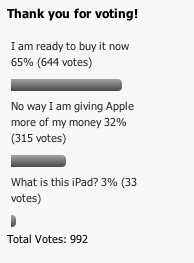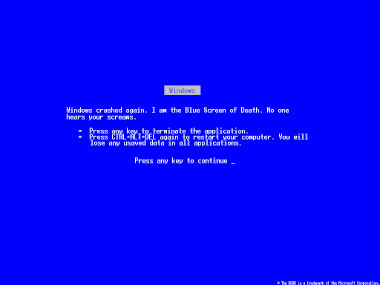 AppleInsider | February Mac sales up 43%, Apple on track for 2.9M in quarter
AppleInsider | February Mac sales up 43%, Apple on track for 2.9M in quarter
This is shaping up to be a bigger blow-out than the usual blow-outs.
 AppleInsider | February Mac sales up 43%, Apple on track for 2.9M in quarter
AppleInsider | February Mac sales up 43%, Apple on track for 2.9M in quarter
This is shaping up to be a bigger blow-out than the usual blow-outs.
Tim Bray Throws His Hat Into The Android Ring Because He Hates The iPhone
Sorry Tim, get used to it. Your idea that software writers should have the right to put their software on anybody’s hardware is coming to an end. That is a privilege not a right.
No vendor has the right to put their product on the shelf of any retailer in the world. It takes a lot of hard work and no small amount of luck to have your product distributed. The software world will be no different.
An estimated one in five iPhone developers are companies founded specifically to create applications for the iPhone, according to the latest Flurry Smartphone Industry Pulse survey. That represents the second-largest category of developers behind only preexisting online companies, including giants like Google, Facebook and eBay. Those established brands take up 22 percent of the iPhone developer share.
link: AppleInsider | Startup developers represent one in five on Apple’s App Store
Flurry argues that with 75 million units sold, the platform is reaching a critical mass where major brands being to take a dominant position in terms of position and sales rank.
This argument is suggesting that the platform will be a sustaining technological improvement to existing industries such as traditional media, online media, retail and traditional gaming.
Since the App Store launched in July 2008, 35,000 unique companies have released applications, which translates to 58 new companies launching apps each day. This appears to be the largest amassing of 3rd party developer support by any development platform in such a compressed timeframe. For example, comparing the number of applications created for the Facebook platform to the App Store over their respective first 9 months, Apple boasted 25,000 apps to Facebook’s 14,000. Comparing respective growth in apps after 14 months, Apple had widened its gap to 85,000 apps over Facebook’s 33,000. At the App Store’s 18 month mark, reached this January, the number of iPhone apps was reported to have exceeded 140,000 compared to 60,000 we estimate Facebook had reached over the same number of months. Apple now leads Facebook with over twice as many available applications. We believe the difference in growth rates can be attributed to the App Store providing better monetization possibilities for application developers than Facebook. Developers, like all rational companies, pursue markets where the path to revenue generation is clear.
link: Flurry Smartphone Industry Pulse, February 2010

Deagol counts about 120k iPad units were pre-ordered on the first day. How do we judge this performance?
South Korea is considering banning access to the Android Marketplace to its residents if Google continues to offer game apps that are not approved by the country’s regulator
link: Korea may block Android Market due to game laws | Electronista
Currently, South Koreans have a choice of two Android-powered smartphones that have access to the Android Marketplace, and more are due for release this year. There are about 4,400 games on the Android Market available to South Koreans, with all of them needing to be rated.
Apple has gone around the South Korean laws by not offering any gaming apps at its App Store for iPhones and iPod touch devices. South Korean developers put up locally approved games under the entertainment category in the App Store, however. Many South Korean iPhone owners create a second account outside of South Korea that does grant them access to games on the App Store as well.
Nearly 10,000 iPhone users were accessing the Microsoft employee email system last year, say two people who heard the estimates from senior Microsoft executives. That figure equals about 10% of the company’s global work force.
link: Microsoft Employees Love Gadgets, but iPhone Fans Lie Low – WSJ.com
I vehemently disagree with this premise:
Nokia did not take advantage of any of the opportunities that it had by being in first place. It failed to leverage its partnerships with carriers, manufacturers, software developers, and content companies.
link: The Below Average CEO: Olli-Pekka Kallasvuo Of Nokia (NOK) – 24/7 Wall St.
When disrupted, large incumbents invariably fail to respond adequately to the threat.
You can only blame management if the threat is symmetric and they fail to take up the challenge. This failure almost never happens.
Asymmetric competition is intractable in almost all instances. This failure always happens. A response in kind by management is usually worthy of dismissal “for cause”.
Apropos the IP lawsuit between Apple and HTC, it’s perhaps instructive to look back at memorable patent suits. The following excerpt tells the story of how patent royalties were litigated for weapons that the litigants also used as belligerents against each other.
The tale shows that not even global war can affect the outcome of patent law.
From American Rifle http://www.amazon.com/American-Rifle-Biography-Alexander-Rose/dp/0553805177, Roosevelt’s Rifle Chapter, Pages 271-278.
On April 5 1905 the Treasury approved royalty payments of 75 cents per rifle plus 50 cents per thousand clips, up to a ceiling of $200,000. Seven months later, on Novemeber 6, Mauser’s accountants were pleased to receive the first (for $11,367.53) in a four-year-long series of checks adding up to the $200,000 maximum.
[General William Crozier who became Chief of Ordance of the Army in 1901 overseeing production for the nation’s weapons] made an energetic start on the new .30-06 bullet, introduced on October 15, 1906. Early the following year he received an ominous visit from a very polite but insistent representative of Deutsche Waffen Munitionsfabriken (DWM), maker of the Spitzer bullets for the Mauser rifle. The .30-06, he said, was a near-copy of DWM’s “projectile for hand-firearms”, which had been submitted to the Patent Office on February 20, 1905–about the same time, suspiciously, that Crozier had been finalizing the financial details of the settlement with Mauser–and approved on January 22, 1907.
The good news was that DWM had a far weaker case than Mauser’s–it was difficult to demonstrate that the shape and dimensions of such a common item as a bullet were unique–and Crozier’s patent attorneys advised him to fight the case. Crozier, again fearful that the newspapers would find out about this charge (even if it was trumped up by an opportunistic DWM), decided to fend off the accusers by stalling. He appointed his deputy, Lieutenant Colonel John Thompson (inventor-to-be of the famous tommy gun), to take care of the negotiations in the hope that they would go on for years.
…
In the summer of 1914 [8 years after the accusation] his deputy Thompson had finally run out the clock regarding Ordnance’s alleged infringement of DWM bullet patents. DWM had made repeated offers to Thompson asking him to settle quickly, and each time they had been rebuffed. On July 18, 1914, less than a month before the outbreak of the cataclysmic Great War, in which millions of men would be killed by pointed bullets, DWM finally lost its patience and sued the government in the U.S. Court of Claims for royalties on 250 million Spitzer bullets totaling $250,000. Ten days later, when Austria-Hungary declared war on Serbia, the suit was deferred.Crozier’s position was saved by the sinking of the Lusitania in 1915 and the U.S. declaration of war on Germany in April 1917. Upon entry to the war, under authority of the Trading with the Enemy Act, the government created the Office of Alien Property Custodian to oversee the seizure of enemy-owned or enemy-controlled assets. To Crozier’s immense relief, the DWM patent was ruled to be U.S. property, and the attorney general dismissed the company’s suit out of hand.
Crozier retired in 1919 and escaped the censure for the fallout from a reinvigorated lawsuit launched by DWM in 1920 [two years after the WWI ended]. Having given up on obtaining a favorable patent-infringement judgement, DWM’s lawyers focused on whether the alien property custodian’s seizure of the patent had been lawful. Impressed by DWM’s argument that its bullet was protected by previous treaty, a tribunal ruled the U.S. government in violation and awarded DWM damages of $300,000.
Washington immediately appealed the decision, and the case lurched on interminably, for another seven and a half years, until it was finally settled on the last day of 1928, a generation after its beginning. The judgement stood. With interest added on the original $300,000, the United States owed a German company $412,520.55 [for the rights to the bullet they used against Germany in two World Wars].
Read more:
http://en.wikipedia.org/wiki/Mauser
http://en.wikipedia.org/wiki/Springfield_1903 “Still, the 1903’s used so many design features from the German Mauser that the U.S. government paid royalties to Mauserwerke”
http://en.wikipedia.org/wiki/Spitzer_(bullet)
 I always thought Windows 2000 was the point of over-service for Microsoft. The book linked below puts a date on the point when Microsoft could and should have created an autonomous division whose task would be to create the platform that would eventually disrupt its core business.
I always thought Windows 2000 was the point of over-service for Microsoft. The book linked below puts a date on the point when Microsoft could and should have created an autonomous division whose task would be to create the platform that would eventually disrupt its core business.
Clearly Microsoft did not do this but Apple, with iPad, did.
In September 1999, Kodesh wrote a memo to Gates and Ballmer under the heading “Starting from Scratch.” We need to kill Windows CE for those categories, he argued. Win32 is not an advantage; it’s a tax on device design. It served to further Microsoft’s strategy but not to help consumers. Given all their other alternatives, electronics manufacturers wouldn’t pay the tax. Kodesh wanted to take a small group of developers and work solely on developing the best software for information appliances, unconstrained by the needs of the rest of the company. Gates rejected the suggestions. “It’s very disappointing you feel that way,” he told Kodesh. “We don’t have time to start from scratch.”
link: Who Fatally Wounded Microsoft? It Was Bill Gates. « Mike Cane’s iPad Test